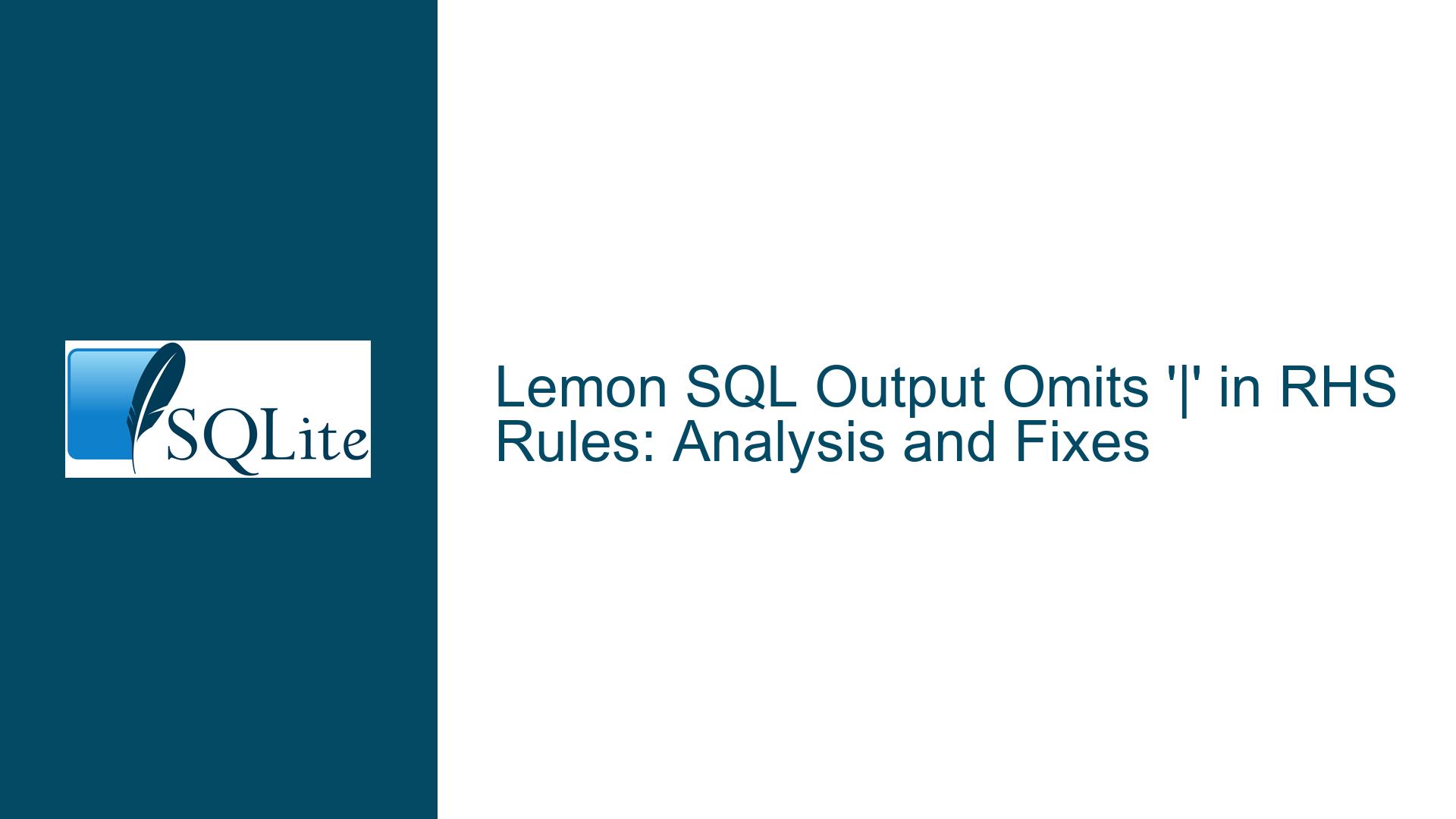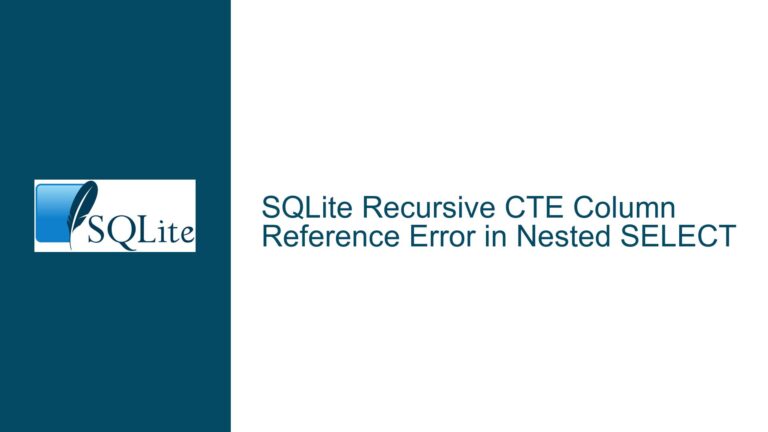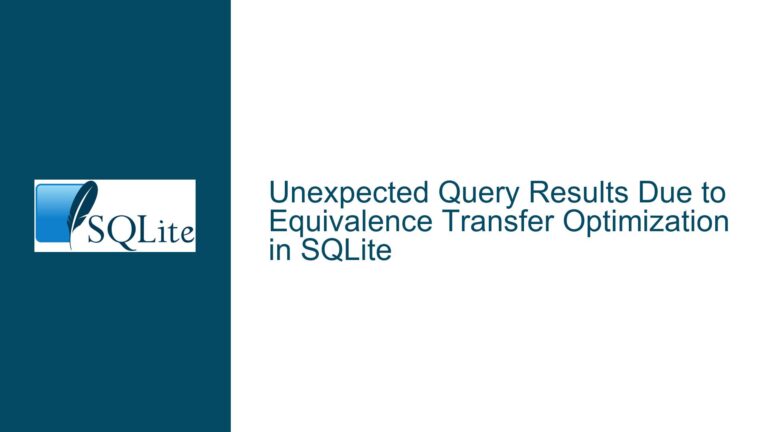Lemon SQL Output Omits ‘|’ in RHS Rules: Analysis and Fixes
Issue Overview: Lemon SQL Output Omits ‘|’ in RHS Rules
When using Lemon, a popular LALR(1) parser generator, to generate SQL output for railroad diagrams, a critical issue arises in the representation of rules that contain the ‘|’ (OR) operator on the right-hand side (RHS). Specifically, Lemon’s SQL output fails to preserve the ‘|’ operator in the RHS of rules, leading to incorrect or incomplete representations of the grammar. This issue is particularly evident when attempting to reconstruct the original grammar rules from the SQL output for visualization or further processing.
For example, consider the rule cmd ::= COMMIT|END(X) trans_opt from the SQLite parser grammar (sqlite3/src/parse.y). The Lemon SQL output for this rule is as follows:
INSERT INTO rule(ruleid,lhs,txt)VALUES(8,189,'cmd ::= COMMIT|END trans_opt');
INSERT INTO rulerhs(ruleid,pos,sym)VALUES(8,0,10);
INSERT INTO rulerhs(ruleid,pos,sym)VALUES(8,0,11);
INSERT INTO rulerhs(ruleid,pos,sym)VALUES(8,1,191);
Here, the ‘|’ operator is missing in the rulerhs table, which stores the symbols on the RHS of the rule. This omission disrupts the accurate reconstruction of the original grammar, as demonstrated by the following query attempting to generate the railroad diagram:
select name || ' ::= ' || group_concat(rhs, '
|')
from (
select id, name, group_concat(ifnull(rhs_name, '/* empty */'), ' ') as rhs
from (
select symbol.id, symbol.name, rule.ruleid, rulerhs.pos, rulerhs.sym, s2.name as rhs_name
from symbol
left join rule on symbol.id=rule.lhs
left join rulerhs on rule.ruleid=rulerhs.ruleid
left join symbol as s2 on rulerhs.sym=s2.id
where symbol.isTerminal=0
order by symbol.id, rule.ruleid, rulerhs.pos
) as tbl
group by id, ruleid
) as tbl2
group by id
The output of this query incorrectly represents the rule as cmd ::= COMMIT END trans_opt, omitting the ‘|’ operator entirely. This issue is not merely cosmetic; it affects the accuracy of the grammar representation and any downstream processing that relies on it.
Possible Causes: Why Lemon Omits ‘|’ in RHS Rules
The omission of the ‘|’ operator in Lemon’s SQL output can be attributed to several factors, including the design of Lemon’s internal data structures, the way rules are parsed and stored, and the limitations of the SQL schema used to represent the grammar.
Lemon’s Internal Representation of Rules
Lemon processes grammar rules by breaking them down into individual symbols and storing them in a structured format. The ‘|’ operator, which denotes alternative productions, is treated as a separator rather than a symbol in its own right. When Lemon generates SQL output, it iterates over the symbols in the RHS of each rule and inserts them into the rulerhs table. However, the ‘|’ operator is not included in this iteration, as it is not considered a symbol.
For example, in the rule cmd ::= COMMIT|END(X) trans_opt, Lemon identifies COMMIT, END, and trans_opt as symbols but does not recognize ‘|’ as a symbol to be stored. This leads to the omission of the ‘|’ operator in the SQL output.
Limitations of the SQL Schema
The SQL schema used by Lemon to store grammar rules consists of two main tables: rule and rulerhs. The rule table stores the left-hand side (LHS) of the rule and the original rule text, while the rulerhs table stores the symbols on the RHS of the rule along with their positions.
The schema does not include a mechanism to represent the ‘|’ operator explicitly. Instead, the operator is embedded in the txt column of the rule table as part of the original rule text. When reconstructing the rule from the SQL output, the ‘|’ operator must be inferred from the original rule text, which is not always straightforward.
For example, the txt column for the rule cmd ::= COMMIT|END(X) trans_opt contains the string 'cmd ::= COMMIT|END trans_opt'. However, the rulerhs table only contains the symbols COMMIT, END, and trans_opt, with no indication of the ‘|’ operator between COMMIT and END.
Parsing and Reconstruction Challenges
Reconstructing the original rule from the SQL output requires parsing the txt column to identify the positions of the ‘|’ operators. This process is complicated by the fact that the txt column may contain additional information, such as comments or annotations, that are not relevant to the rule structure.
For example, the txt column may contain strings like 'cmd ::= COMMIT|END(X) trans_opt /* comment */', which must be parsed to extract the rule text and identify the positions of the ‘|’ operators. This parsing step is error-prone and may lead to incorrect reconstructions if not handled carefully.
Troubleshooting Steps, Solutions & Fixes: Addressing the Omission of ‘|’ in RHS Rules
To address the issue of Lemon omitting the ‘|’ operator in the RHS of rules, several approaches can be taken, ranging from modifying the SQL schema to adjusting the query used to reconstruct the rules. Below, we explore these approaches in detail.
Modifying the SQL Schema to Include ‘|’ Operators
One approach to resolving the issue is to modify the SQL schema used by Lemon to explicitly include the ‘|’ operator in the rulerhs table. This would involve adding a new column to the rulerhs table to indicate the presence of a ‘|’ operator between symbols.
For example, the rulerhs table could be modified as follows:
CREATE TABLE rulerhs (
ruleid INTEGER, -- ID of the rule
pos INTEGER, -- Position of the symbol in the RHS
sym INTEGER, -- ID of the symbol
isOr INTEGER -- 1 if a '|' operator follows this symbol, 0 otherwise
);
With this modified schema, the SQL output for the rule cmd ::= COMMIT|END(X) trans_opt would be:
INSERT INTO rule(ruleid,lhs,txt)VALUES(8,189,'cmd ::= COMMIT|END trans_opt');
INSERT INTO rulerhs(ruleid,pos,sym,isOr)VALUES(8,0,10,1);
INSERT INTO rulerhs(ruleid,pos,sym,isOr)VALUES(8,1,11,0);
INSERT INTO rulerhs(ruleid,pos,sym,isOr)VALUES(8,2,191,0);
This modification allows the ‘|’ operator to be explicitly represented in the SQL output, making it easier to reconstruct the original rule.
Adjusting the Query to Infer ‘|’ Operators from the txt Column
If modifying the SQL schema is not feasible, an alternative approach is to adjust the query used to reconstruct the rules to infer the presence of ‘|’ operators from the txt column. This approach involves parsing the txt column to identify the positions of the ‘|’ operators and incorporating them into the reconstructed rule.
The following query demonstrates this approach:
select name || ' ::=' || group_concat(
case when hasOr == 1 then ' (' || trim(rtxt) || ')'
else
case when length(rtxt) == 0 then ' /* empty */' else rtxt end
end, '
|')
from (
select lhs, name, substr(txt, instr(txt, tbl.sep) + length(tbl.sep)) rtxt, (instr(txt, '|') > 0) hasOr
from rule left join symbol on lhs=id, (select '::=' as sep) tbl
) as t
group by lhs;
This query works by extracting the RHS of each rule from the txt column and checking for the presence of the ‘|’ operator. If a ‘|’ operator is found, it is included in the reconstructed rule. The output of this query correctly represents the rule as cmd ::= (COMMIT|END) trans_opt, preserving the ‘|’ operator.
Enhancing Lemon to Preserve ‘|’ Operators in SQL Output
A more comprehensive solution is to enhance Lemon itself to preserve the ‘|’ operators in the SQL output. This would involve modifying Lemon’s code to treat the ‘|’ operator as a symbol and include it in the rulerhs table.
The following steps outline the process of enhancing Lemon:
- Modify the Grammar Parsing Logic: Update Lemon’s grammar parsing logic to recognize the ‘|’ operator as a symbol and assign it a unique symbol ID.
- Update the SQL Generation Logic: Modify the SQL generation logic to include the ‘|’ operator in the
rulerhstable when generating SQL output. - Update the Schema: Ensure that the SQL schema used by Lemon is compatible with the inclusion of the ‘|’ operator in the
rulerhstable.
With these modifications, Lemon would generate SQL output that explicitly includes the ‘|’ operator, eliminating the need for post-processing to reconstruct the original rule.
Conclusion
The omission of the ‘|’ operator in Lemon’s SQL output is a significant issue that affects the accurate representation of grammar rules. By understanding the root causes of this issue and exploring potential solutions, such as modifying the SQL schema, adjusting the reconstruction query, or enhancing Lemon itself, it is possible to address this issue and ensure the accurate representation of grammar rules in SQL output. Each approach has its trade-offs, and the choice of solution will depend on the specific requirements and constraints of the project.






